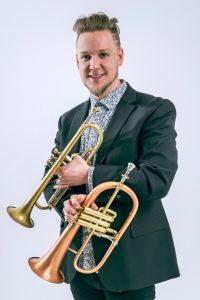Despite the challenges of social distancing and virtual instruction, the COVID-19 pandemic has inspired some creative collaborations that span not only academic disciplines, but hundreds of miles. Adam Meckler (VPA), Michigan Tech’s director of jazz studies, recently connected with a former college classmate and both brought along students for the collaboration.

The project is a video/audio exchange between Meckler’s jazz students at Michigan Tech and students from the Department of Dance at the State University of New York-Brockport. Meckler’s partner at SUNY-Brockport is Greg Woodsbie, lead professional staff accompanist and music instructor. Meckler said the idea of a jazz/dance collaboration began to take shape when he and Woodsbie were undergraduates at Lawrence University in Appleton, Wisconsin, nearly 15 years ago.
“We played in many bands together over the years, but the first was a 12-piece salsa band when we were students at Lawrence,” Meckler said. While the salsa band spent many hours rehearsing, they didn’t “get it” until their first gig. “There were dancers there. It was then that we recognized how the dancers elevated the music and likewise how the music elevated the dancers.”
It is this mutual elevation that Meckler and Woodsbie’s students are exploring, even though they are more than 800 miles apart. “Each Tech student is paired with a dancer,” Meckler explained. “Our jazz students will send over 30 seconds of recorded music and the dancers will send over 30 seconds of dance.”
The guidelines are simple — there aren’t any. “The music can be anything the students can dream up and execute,” he said. “Some will improvise on a trumpet, trombone or saxophone while some might record multiple layers and instruments.” The same goes for the dancers — their contribution can be virtually anything.
Once the students exchange material, the fun begins. “The musician will record music over the dance video and the dancer will do some kind of choreography to the music sent in the exchange,” Meckler said. Following a dialogue to discuss what worked and what didn’t, the students will vote on their favorite collaborations, with the winners forming a single video to be released on social media.
Meckler said he and Woodsbie feel the collaboration goes to the heart of the two art forms. “Historically, music and dance are not two separate art forms, but one. We are well-served to explore these folkloric roots, in turn integrating art into our lives and culture.”
At the same time, it’s also a fun and healthy form of symbiosis — musicians and dancers complementing each other. “The dialogue between music and dance elevates both parties,” he said. “Dancers deepen the practice that is crucial to artists — developing an intimate relationship with your materials. Musicians are reminded of the body and that music ultimately comes from movement.”
Meckler, Woodsbie and their students are proving that creativity and art can flourish, even in the time of social distancing. As Meckler puts it, “The dialogue between the dancer and the musician will teach both parties the benefits and challenges of interdisciplinary collaboration. The participants will observe these benefits and challenges and will discuss perceived successes and failures in dialogue throughout this process.”